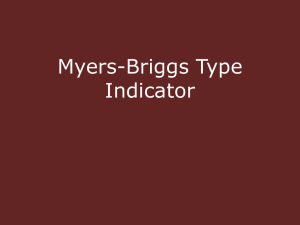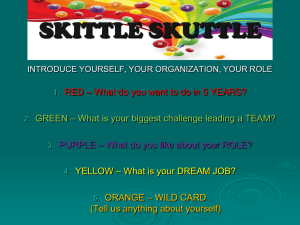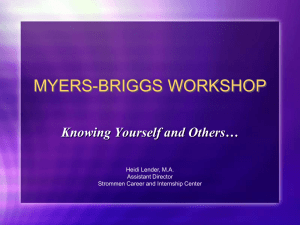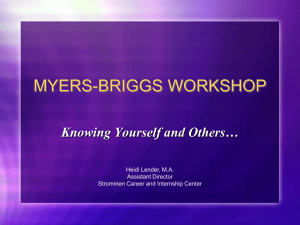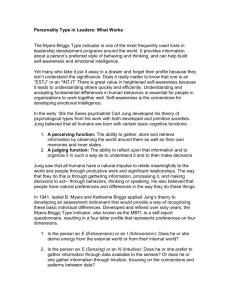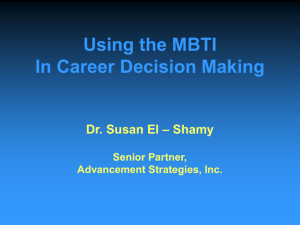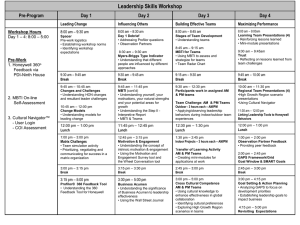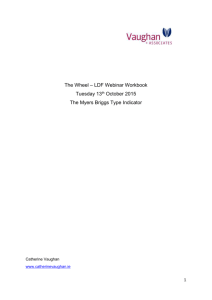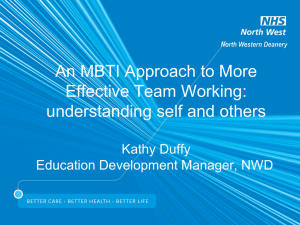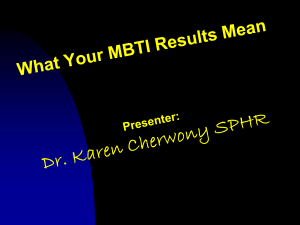MBTI - Kent, Surrey and Sussex Leadership Collaborative
advertisement
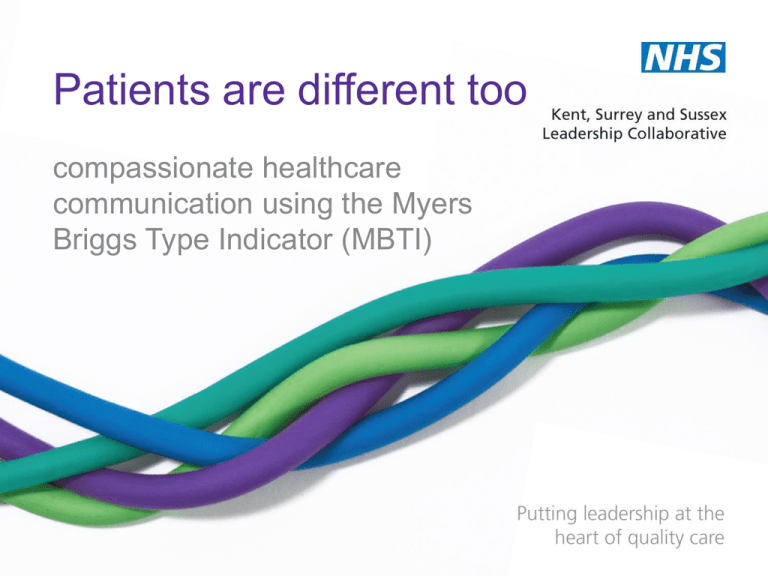
Patients are different too compassionate healthcare communication using the Myers Briggs Type Indicator (MBTI) The Myers Briggs Type Indicator (MBTI) The MBTI is a widely used model of personality that builds self-awareness and an appreciation of important differences between people, demonstrating how different types can work together in a complementary way. Our Community of Practice The aim of our MBTI Community of Practice is provide the NHS in Kent, Surrey and Sussex with in-house expertise in the MBTI. Our skilled practitioners use the MBTI with individuals, groups and teams. They offer the best value for money together with the benefit of NHS insight and experience, when compared to external MBTI consultants. What experience is in the room? Experience of the MBTI? Direct patient contact? Been/are a patient or carer? Key messages It is important to recognize, understand and value different styles of communication. If we can understand and value different approaches we may unlock qualities in both ourselves and the other person which will allow us to work more effectively together Within the health care setting communication is fundamental to good care and good team work Dissatisfaction and complaints often relate more to what was said (or the way it was said) than what was done The Golden Rule Do unto others as you would have them do to you But Often how you want others to treat you is very different from how your colleagues, friends, family and patients want to be treated People are different and patients are different too The revised rule Do unto others as they would want done to them “Compassion (in nursing) involves focusing on another person’s needs and channeling the emotion generated into an active response” (Davison & Williams, 2009) Exercise Reflect for a few moments on your own experience as a patient, preferably one good experience and one less good. It may help to make some notes. Taking the good experience first, consider: What struck you as particularly positive about this exchange? Turning to the less good experience: What was it you found difficult about this exchange? Our assumptions People prefer to communicate in different ways Most people have a preferred style of communication It is easier to communicate with some people than it is with others A system exists which provides a simple framework for understanding these differences The three stages of ‘flex care’ 1. Identifying your own preferred styles of communication 2. Tuning in to the other person’s current communication needs 3. Adjusting (or ‘flexing’) your approach, if necessary, to match those needs Knowing you An awareness of your own preferred behaviour makes it easier for you to understand your own part in the communication Everyday communication We all use all the preferences in everyday communication – we just differ by order and emphasis – this is what we call personality preference THE MBTI PREFERENCES Extraversion or Introversion Where you prefer to get and focus your ‘energy’ or attention Sensing or iNtuition What kind of information you prefer to gather and trust Thinking or Feeling What process you prefer to use in coming to decisions Judging or Perceiving How you prefer to deal with the world around you, your ‘lifestyle’ Extraversion and Introversion – behaviour cues Talk it out Rapid speech Appears to ‘think aloud’ Interrupts Louder volume of voice Think it through Pauses while giving information Quieter voice volume Shorter sentences – not run on Sensing and iNtuition – behaviour cues Specifics Asks for step-by-step information or instruction Asks, “what”, “how” questions Uses precise descriptions Shows interest in factual details Big Picture Asks for current and longrange implications Asks “why” questions Talks in general terms Wants multiple options Thinking and Feeling – behaviour cues Logical Implications Appears to be “testing you” or your knowledge Weighs the objective evidence Not impressed that others have decided in favour Conversations follow a pattern of logic – “if this, then that” Impact on People Strives for harmony in interaction May talk about what they value Asks how others acted/resolved the situation Matters to them whether others have been taken into account Thinking – logical implications When I visit the doctor, I want to know she really understands my case, is experienced and knowledgeable about it. I don’t want her to humour me, just give me information about my problem and what can be done about it. I want to be treated as an intelligent adult and that means being told the truth Feeling – impact on people I prefer it if the doctor knows about me and my case and shows an interest in me personally. I want to know about my condition and how other people have reacted to the proposed treatment. I prefer a kindly approach, sometimes I feel hurt by blunt comments. Judging and Perceiving behaviour cues Joy of Closure Consistently early or on time for appointments Impatient with overly long descriptions or procedures. The tone is “let’s get it done”. May even decide prematurely Uses “ed” words: “looked, compared, evaluated” Joy of Perceiving May be late for appointments or forget the time during an appointment Seems to want “space” to make own decisions Feels put off by closing a conversation before they’re ready Generally won’t decide until the last moment Uses “ing” words; “looking, comparing, exploring” EXERCISE In your good and less good examples, can you identify any behaviour cues exhibited by the practitioner? Do they match your own preferences? If they didn’t match how did this affect your interaction? Discuss with your neighbour FLEX TALK A FOCUS ON HOW OTHERS COMMUNICATE This is important because – Effective communication requires that we tune in to other people – There are two important parts to our work: 1. 2. The WHAT - the skills/knowledge/experience we bring to interactions The HOW – the way in which we interact and communicate – Communication is increasingly important • Services and expectations are developing ever faster and often have to be discussed in the context of financial and time constraints. As the WHAT becomes more complex, the HOW becomes more important MODE NOT TYPE It is impractical for us to ‘type’ with everyone we meet Type is simply a preference, we may not always be ‘in type’ – If we assume that because we know someone’s type we will always experience them in the same way, we could be misled We are looking for a type ‘mode’; what that person needs at a certain moment Stages of Interacting 1. Initiating the interaction 2. Investigating needs 3. Suggesting a course of action 4. Obtaining agreement & closing The four-part FLEX framework STAGES PREFERENCES Initiating E – Talk it out I – Think it through Investigating and Suggesting ST – facts with Practicality SF – personal service NF – support their vision NT – logical options Next steps or closing J – joy of closure P – joy of processing Our Health Care Communications Using Personality Type Programme Provides an in-depth understanding of your personality type and preferred communication style Teaches ways in which you can learn to FLEX your approach to match the needs of patients Provides help in using this framework at work to improve communications and provide better outcomes for patients (and less stress for you and your teams) EXERCISE TO TAKE AWAY Consider now what your own preferences might be and how they might affect your communication with the patients (or colleagues) with whom you are working. Is there any connection between your needs as a patient and the way you tend to give information to your patients?
